High-Pressure Game Conditions Affect Quiet Eye Depending on the Player’s Expertise: Evidence from the Basketball Three-Point Shot
Abstract
:1. Introduction
2. Materials and Methods
2.1. Participants
2.2. Equipment
2.3. Measures
2.3.1. Shot Accuracy
2.3.2. Action Time
2.3.3. Demand and Resource Evaluation Score (DRES) and Trait Anxiety (STAI-Y2)
2.3.4. QE Onset
2.3.5. QE Duration
2.3.6. QE Offset
2.3.7. QE Preprogramming and Online Duration
2.4. Task and Protocol
2.5. Data Analysis
3. Results
3.1. Shot Accuracy
3.1.1. Points
3.1.2. Shooting Percentage
3.2. Action Time
3.3. Demand and Resource Evaluation Score (DRES)
3.4. QE Onset
3.5. QE Duration
3.6. QE Offset
3.7. QE Preprogramming
3.8. QE Online Duration
4. Discussion
5. Conclusions
Author Contributions
Funding
Institutional Review Board Statement
Informed Consent Statement
Data Availability Statement
Acknowledgments
Conflicts of Interest
Appendix A
| Results | df, df Error | F | p-Value | Partial η² |
|---|---|---|---|---|
| EXP | 1, 21.193 | 2.487 | 0.130 | 0.105 |
| TP | 1, 819.123 | 1.129 | 0.288 | 0.001 |
| TO | 1, 820.537 | 0.112 | 0.738 | 0.000 |
| EXP × TO | 1, 820.537 | 0.042 | 0.837 | 0.000 |
| TP × TO | 1, 819.883 | 0.364 | 0.547 | 0.000 |
| PP × TO | 1, 819.601 | 0.278 | 0.598 | 0.000 |
| EXP × TP × TO | 1, 819.883 | 0.000 | 0.996 | 0.000 |
| TP × PP × TO | 1, 820.218 | 0.062 | 0.803 | 0.000 |
| EXP × TP × PP × TO | 1, 820.218 | 0.391 | 0.532 | 0.000 |
| Results | df, df Error | F | p-Value | Partial η² |
|---|---|---|---|---|
| TP | 1, 819 | 2.552 | 0.111 | 0.003 |
| PP | 1, 819 | 0.885 | 0.347 | 0.001 |
| EXP × TP | 1, 819 | 2.023 | 0.155 | 0.002 |
| EXP × PP | 1, 819 | 0.656 | 0.418 | 0.001 |
| TP × PP | 1, 819 | 0.253 | 0.615 | 0.000 |
| EXP × TP × PP | 1, 819 | 2.023 | 0.155 | 0.002 |
| Results | df, df Error | F | p-Value | Partial η² |
|---|---|---|---|---|
| EXP | 1, 21 | 0.076 | 0.786 | 0.004 |
| TP × PP | 1, 819 | 0.035 | 0.851 | 0.000 |
| EXP × TP × PP | 1, 819 | 0.317 | 0.574 | 0.000 |
| Results | df, df Error | F | p-Value | Partial η² |
|---|---|---|---|---|
| EXP | 1, 22.077 | 0.000 | 0.994 | 0.000 |
| PP | 1, 819.361 | 1.605 | 0.206 | 0.002 |
| TO | 1, 827.054 | 0.072 | 0.788 | 0.000 |
| EXP × TP | 1, 819.662 | 0.753 | 0.386 | 0.001 |
| EXP × PP | 1, 819.361 | 0.445 | 0.505 | 0.001 |
| TP × PP | 1, 820.517 | 0.048 | 0.826 | 0.000 |
| TP × TO | 1, 823.806 | 0.799 | 0.372 | 0.001 |
| PP × TO | 1, 822.314 | 1.956 | 0.162 | 0.002 |
| EXP × TP × TO | 1, 823.806 | 0.453 | 0.501 | 0.001 |
| TP × PP × TO | 1, 825.514 | 0.001 | 0.977 | 0.000 |
| EXP × PP × TO | 1, 822.314 | 0.329 | 0.566 | 0.000 |
| EXP × TP × PP × TO | 1, 825.514 | 0.172 | 0.678 | 0.000 |
| Results | df, df Error | F | p-Value | Partial η² |
|---|---|---|---|---|
| EXP | 1, 21.899 | 0.884 | 0.357 | 0.039 |
| PP | 1, 819.307 | 1.625 | 0.203 | 0.002 |
| TO | 1, 825.807 | 0.003 | 0.955 | 0.000 |
| EXP × TP | 1, 819.557 | 0.000 | 0.987 | 0.000 |
| EXP × PP | 1, 819.307 | 0.630 | 0.427 | 0.001 |
| EXP × TO | 1, 825.807 | 2.688 | 0.101 | 0.003 |
| TP × PP | 1, 820.268 | 0.073 | 0.788 | 0.000 |
| TP × TO | 1, 823.028 | 0.638 | 0.425 | 0.001 |
| PP × TO | 1, 821.769 | 1.327 | 0.250 | 0.002 |
| EXP × TP × TO | 1, 823.028 | 0.168 | 0.682 | 0.000 |
| TP × PP × TO | 1, 824.48 | 0.104 | 0.747 | 0.000 |
| EXP × PP × TO | 1, 821.769 | 0.003 | 0.953 | 0.000 |
| EXP × TP × PP × TO | 1, 824.48 | 0.102 | 0.749 | 0.000 |
| Results | df, df Error | F | p-Value | Partial η² |
|---|---|---|---|---|
| TP | 1, 819.277 | 0.433 | 0.511 | 0.001 |
| PP | 1, 819.152 | 0.010 | 0.919 | 0.000 |
| TO | 1, 822.528 | 0.339 | 0.561 | 0.000 |
| EXP × PP | 1, 819.152 | 0.209 | 0.648 | 0.000 |
| EXP × TO | 1, 822.528 | 1.367 | 0.243 | 0.002 |
| TP × PP | 1, 819.634 | 2.399 | 0.122 | 0.003 |
| TP × TO | 1, 821.045 | 0.086 | 0.770 | 0.000 |
| PP × TO | 1, 820.394 | 0.433 | 0.511 | 0.001 |
| EXP × TP × PP | 1, 819.634 | 1.029 | 0.311 | 0.001 |
| EXP × TP × TO | 1, 821.045 | 0.488 | 0.485 | 0.001 |
| TP × PP × TO | 1, 821.81 | 0.686 | 0.408 | 0.001 |
| EXP × PP × TO | 1, 820.394 | 2.292 | 0.130 | 0.003 |
| EXP × TP × PP × TO | 1, 821.81 | 0.067 | 0.795 | 0.000 |
| Results | df, df Error | F | p-Value | Partial η² |
|---|---|---|---|---|
| EXP | 1, 21.317 | 0.216 | 0.647 | 0.010 |
| PP | 1, 630.059 | 0.301 | 0.584 | 0.000 |
| TO | 1, 635.397 | 0.083 | 0.773 | 0.000 |
| EXP × TP | 1, 629.886 | 1.391 | 0.239 | 0.002 |
| EXP × PP | 1, 630.059 | 0.536 | 0.464 | 0.001 |
| EXP × TO | 1, 635.397 | 2.391 | 0.123 | 0.004 |
| TP × PP | 1, 630.379 | 0.552 | 0.458 | 0.001 |
| TP × TO | 1, 633.510 | 0.393 | 0.531 | 0.001 |
| PP × TO | 1, 630.790 | 1.085 | 0.298 | 0.002 |
| EXP × TP × TO | 1, 633.510 | 0.013 | 0.908 | 0.000 |
| TP × PP × TO | 1, 635.075 | 0.060 | 0.806 | 0.000 |
| EXP × PP × TO | 1, 630.790 | 0.130 | 0.719 | 0.000 |
| EXP × TP × PP × TO | 1, 635.075 | 0.002 | 0.965 | 0.000 |
| Results | df, df Error | F | p-Value | Partial η² |
|---|---|---|---|---|
| TP | 1, 789.520 | 1.734 | 0.188 | 0.002 |
| TO | 1, 791.456 | 0.136 | 0.712 | 0.000 |
| EXP × TO | 1, 791.456 | 0.717 | 0.397 | 0.001 |
| TP × TO | 1, 790.853 | 0.092 | 0.762 | 0.000 |
| PP × TO | 1, 790.285 | 0.003 | 0.953 | 0.000 |
| EXP × TP × TO | 1, 790.853 | 0.900 | 0.343 | 0.001 |
| TP × PP × TO | 1, 791.066 | 1.333 | 0.249 | 0.002 |
| EXP × PP × TO | 1, 790.285 | 0.161 | 0.688 | 0.000 |
| EXP × TP × PP × TO | 1, 791.066 | 0.368 | 0.544 | 0.000 |
Appendix B
| Throw Outcome | Expertise | Condition | |||
|---|---|---|---|---|---|
| NOTP/NOPP | NOTP/PP | TP/NOPP | TP/PP | ||
| Hit | CE | 471.457 (32.184) | 481.058 (32.036) | 439.017 (32.789) | 558.023 (32.993) |
| SE | 428.201 (39.261) | 427.911 (40.703) | 409.33 (40.938) | 388.696 (39.28) | |
| Miss | CE | 489.865 (32.184) | 473.809 (32.371) | 461.523 (31.821) | 528.297 (31.734) |
| SE | 428.158 (36.31) | 445.221 (36.132) | 394.545 (36.098) | 402.67 (36.313) | |
| Throw Outcome | Expertise | Condition | |||
|---|---|---|---|---|---|
| NOTP/NOPP | NOTP/PP | TP/NOPP | TP/PP | ||
| Hit | CE | −617.982 (76.96) | −724.137 (75.702) | −595.13 (81.888) | −581.808 (83.507) |
| SE | −775.285 (105.4) | −695.28 (115.823) | −662.332 (117.533) | −668.324 (105.523) | |
| Miss | CE | −785.191 (76.96) | −784.518 (78.513) | −682.497 (73.847) | −509.903 (73.088) |
| SE | −746.578 (81.466) | −580.77 (79.863) | −588.525 (79.561) | −569.064 (81.492) | |
| Throw Outcome | Expertise | Condition | |||
|---|---|---|---|---|---|
| NOTP/NOPP | NOTP/PP | TP/NOPP | TP/PP | ||
| Hit | CE | 712.865 (82.791) | 805.442 (81.574) | 707.968 (87.593) | 665.884 (89.174) |
| SE | 787.087 (111.765) | 690.507 (122.059) | 624.239 (123.74) | 654.558 (111.888) | |
| Miss | CE | 851.576 (82.791) | 860.578 (84.3) | 762.975 (79.784) | 637.662 (79.052) |
| SE | 801.38 (88.458) | 584.907 (86.921) | 567.075 (86.63) | 566.588 (88.484) | |
| Throw Outcome | Expertise | Condition | |||
|---|---|---|---|---|---|
| NOTP/NOPP | NOTP/PP | TP/NOPP | TP/PP | ||
| Hit | CE | 95.27 (33.255) | 81.494 (32.949) | 112.338 (34.49) | 86.152 (34.901) |
| SE | 14.178 (42.615) | −4.256 (45.403) | −39.25 (45.855) | −14.186 (42.65) | |
| Miss | CE | 65.998 (33.255) | 75.845 (33.64) | 80.822 (32.502) | 126.467 (32.32) |
| SE | 53.837 (36.619) | 3.989 (36.243) | −21.141 (36.171) | −2.305 (36.626) | |
| Throw Outcome | Expertise | Condition | |||
|---|---|---|---|---|---|
| NOTP/NOPP | NOTP/PP | TP/NOPP | TP/PP | ||
| Hit | CE | 494.350 (82.013) | 603.010 (79.108) | 393.001 (84.676) | 398.276 (90.629) |
| SE | 661.638 107.892) | 553.010 (121.287) | 497.613 (120.392) | 563.390 (108.157) | |
| Miss | CE | 579.245 (77.711) | 572.431 (79.452) | 500.240 (74.365) | 419.431 (80.224) |
| SE | 603.171 (84.690) | 424.537 (83.138) | 471.901 (83.258) | 509.705 (87.754) | |
| Throw Outcome | Expertise | Condition | |||
|---|---|---|---|---|---|
| NOTP/NOPP | NOTP/PP | TP/NOPP | TP/PP | ||
| Hit | CE | 386.740 (42.581) | 388.454 (42.353) | 378.659 (43.991) | 464.759 (44.260) |
| SE | 285.777 (53.898) | 305.124 (58.350) | 242.300 (59.104) | 228.001 (54.829) | |
| Miss | CE | 373.178 (42.581) | 372.542 (42.971) | 367.652 (41.945) | 480.097 (41.712) |
| SE | 345.660 (47.614) | 309.975 (47.280) | 223.311 (47.207) | 246.196 (47.686) | |
References
- Vickers, J.N. Visual control when aiming at a far target. J. Exp. Psychol. Hum. Percept. Perform. 1996, 22, 342–354. [Google Scholar] [CrossRef] [PubMed]
- Vickers, J.N. The Quiet Eye: Reply to sixteen commentaries. Curr. Issues Sport Sci. 2016, 1, 118. [Google Scholar] [CrossRef]
- Harle, S.K.; Vickers, J.N. Training quiet eye improves accuracy in the basketball free throw. Sport Psychol. 2001, 15, 289–305. [Google Scholar] [CrossRef]
- Vine, S.J.; Wilson, M.R. The influence of quiet eye training and pressure on attention and visuo-motor control. Acta Psychol. 2011, 136, 340–346. [Google Scholar] [CrossRef] [PubMed]
- Vickers, J.N. The Quiet Eye: Origins, Controversies, and Future Directions. Kinesiol. Rev. 2016, 5, 119–128. [Google Scholar] [CrossRef]
- Fegatelli, D.; Giancamilli, F.; Mallia, L.; Chirico, A.; Lucidi, F. The use of eye tracking (ET) in targeting sports: A review of the studies on quiet eye (QE). In Smart Innovation, Systems and Technologies; Pietro, G., Gallo, L., Howlett, R., Jain, L., Eds.; Springer International Publishing: Cham, Switzerland, 2016; Volume 55, pp. 715–730. ISBN 9783319393445. [Google Scholar]
- Klostermann, A.; Moeinirad, S. Fewer fixations of longer duration? Expert gaze behavior revisited. Ger. J. Exerc. Sport Res. 2020, 50, 146–161. [Google Scholar] [CrossRef]
- Lebeau, J.-C.; Liu, S.; Sáenz-Moncaleano, C.; Sanduvete-Chaves, S.; Chacón-Moscoso, S.; Becker, B.J.; Tenenbaum, G. Quiet eye and performance in sport: A meta-analysis. J. Sport Exerc. Psychol. 2016, 38, 441–457. [Google Scholar] [CrossRef] [PubMed]
- Mann, D.Y.; Williams, A.M.; Ward, P.; Janelle, C.M. Perceptual-cognitive expertise in sport: A meta-analysis. J. Sport Exerc. Psychol. 2007, 29, 457–478. [Google Scholar] [CrossRef]
- Moran, A.; Campbell, M.; Toner, J. Exploring the cognitive mechanisms of expertise in sport: Progress and prospects. Psychol. Sport Exerc. 2019, 42, 8–15. [Google Scholar] [CrossRef]
- Rienhoff, R.; Tirp, J.; Strauß, B.; Baker, J.; Schorer, J. The ‘Quiet Eye’ and Motor Performance: A Systematic Review Based on Newell’s Constraints-Led Model. Sport. Med. 2016, 46, 589–603. [Google Scholar] [CrossRef]
- Vickers, J.N.; Vandervies, B.; Kohut, C.; Ryley, B. Quiet eye training improves accuracy in basketball field goal shooting. Prog. Brain Res. 2017, 234, 1–12. [Google Scholar] [CrossRef] [PubMed]
- Vine, S.J.; Moore, L.J.; Wilson, M.R. Quiet eye training facilitates competitive putting performance in elite golfers. Front. Psychol. 2011, 2, 1–9. [Google Scholar] [CrossRef] [PubMed] [Green Version]
- Vickers, J.N. Perception, Cognition, and Decision Training: The Quiet Eye in Action; Vickers, J.N., Ed.; Human Kinetics: Champaign, IL, USA, 2007; ISBN 978-0-7360-4256-7. [Google Scholar]
- Gonzalez, C.C.; Causer, J.; Miall, R.C.; Grey, M.J.; Humphreys, G.; Williams, A.M. Identifying the causal mechanisms of the quiet eye. Eur. J. Sport Sci. 2017, 17, 74–84. [Google Scholar] [CrossRef] [PubMed] [Green Version]
- Helsen, W.F.; Levin, O.; Ziv, G.; Davare, M. Is a ‘quiet eye’ all it takes to be successful? Comment on Vickers. Curr. Issues Sport Sci. 2016, 1. [Google Scholar] [CrossRef]
- Klostermann, A.; Hossner, E.-J. The quiet eye and motor expertise: Explaining the “efficiency paradox”. Front. Psychol. 2018, 9, 1–7. [Google Scholar] [CrossRef] [Green Version]
- Wilson, M.R.; Wood, G.; Vine, S.J. Say it quietly, but we still do not know how Quiet Eye training works—Comment on Vickers. Curr. Issues Sport Sci. 2016, 1. [Google Scholar] [CrossRef]
- Vine, S.J.; Lee, D.; Moore, L.J.; Wilson, M.R. Quiet eye and choking: Online control breaks down at the point of performance failure. Med. Sci. Sports Exerc. 2013, 45, 1988–1994. [Google Scholar] [CrossRef] [Green Version]
- Eysenck, M.W.; Derakshan, N.; Santos, R.; Calvo, M.G. Anxiety and cognitive performance: Attentional control theory. Emotion 2007, 7, 336. [Google Scholar] [CrossRef] [Green Version]
- Vine, S.J.; Moore, L.J.; Wilson, M.R. An integrative framework of stress, attention, and visuomotor performance. Front. Psychol. 2016, 7, 1671. [Google Scholar] [CrossRef] [Green Version]
- Brams, S.; Ziv, G.; Levin, O.; Spitz, J.; Wagemans, J.; Mark Williams, A.; Helsen, W.F. The relationship between gaze behavior, expertise, and performance: A systematic review. Psychol. Bull. 2019, 145, 980–1027. [Google Scholar] [CrossRef]
- Corbetta, M.; Shulman, G.L. Control of goal-directed and stimulus-driven attention in the brain. Nat. Rev. Neurosci. 2002, 3, 201–215. [Google Scholar] [CrossRef]
- Haider, H.; Frensch, P.A. Eye Movement during Skill Acquisition: More Evidence for the Information-Reduction Hypothesis. J. Exp. Psychol. Learn. Mem. Cogn. 1999, 25, 172–190. [Google Scholar] [CrossRef]
- Harris, D.J.; Wilson, M.R.; Vine, S.J. A critical analysis of the functional parameters of the quiet eye using immersive virtual reality. J. Exp. Psychol. Hum. Percept. Perform. 2021, 47, 308–321. [Google Scholar] [CrossRef] [PubMed]
- Vickers, J.N. Advances in coupling perception and action: The quiet eye as a bidirectional link between gaze, attention, and action. In Progress in Brain Research; Raab, M., Johnson, J., Heekeren, H., Eds.; Elsevier B.V.: Calgary, AB, Canada, 2009; Volume 174, pp. 279–288. ISBN 9780444533562. [Google Scholar]
- Vine, S.J.; Lee, D.H.; Walters-Symons, R.; Wilson, M.R. An occlusion paradigm to assess the importance of the timing of the quiet eye fixation. Eur. J. Sport Sci. 2017, 17, 85–92. [Google Scholar] [CrossRef] [PubMed]
- Chirico, A.; Fegatelli, D.; Galli, F.; Mallia, L.; Alivernini, F.; Cordone, S.; Giancamilli, F.; Pecci, S.; Tosi, G.M.; Giordano, A.; et al. A study of quiet eye’s phenomenon in the shooting section of “laser run” of modern pentathlon. J. Cell. Physiol. 2019, 234, 9247–9254. [Google Scholar] [CrossRef] [PubMed]
- Klostermann, A.; Panchuk, D.; Farrow, D. Perception-action coupling in complex game play: Exploring the quiet eye in contested basketball jump shots. J. Sport Sci. 2018, 36, 1054–1060. [Google Scholar] [CrossRef]
- Klostermann, A. Perception and action in a far-aiming task: Inhibition demands and the functionality of the Quiet Eye in motor performance. Psychol. Sport Exerc. 2020, 50, 101736. [Google Scholar] [CrossRef]
- Rienhoff, R.; Hopwood, M.J.; Fischer, L.; Strauss, B.; Baker, J.; Schorer, J. Transfer of motor and perceptual skills from basketball to darts. Front. Psychol. 2013, 4, 593. [Google Scholar] [CrossRef] [Green Version]
- Causer, J.; Hayes, S.J.; Hooper, J.M.; Bennett, S.J. Quiet eye facilitates sensorimotor preprograming and online control of precision aiming in golf putting. Cogn. Process. 2017, 18, 47–54. [Google Scholar] [CrossRef] [Green Version]
- Walters-Symons, R.; Wilson, M.; Klostermann, A.; Vine, S. Examining the response programming function of the Quiet Eye: Do tougher shots need a quieter eye? Cogn. Process. 2018, 19, 47–52. [Google Scholar] [CrossRef] [Green Version]
- Oudejans, R.D.; Van De Langenberg, R.W.; Hutter, R.I. Aiming at a far target under different viewing conditions: Visual control in basketball jump shooting. Hum. Mov. Sci. 2002, 21, 457–480. [Google Scholar] [CrossRef]
- Marques, R.; Martins, F.; Mendes, R.; Silva, M.C.; Dias, G. The use of eye tracking glasses in basketball shooting: A systematic review. J. Phys. Educ. Sport 2018, 18, 175–183. [Google Scholar] [CrossRef]
- Okubo, H.; Hubbard, M. Kinematic Differences between Set- and Jump-Shot Motions in Basketball. Proceedings 2018, 2, 201. [Google Scholar] [CrossRef] [Green Version]
- Czyz, S.H.; Zvonar, M.; Borysiuk, Z.; Nykodym, J.; Olesniewicz, P. Gaze Behavior in Basketball Free Throws Developed in Constant and Variable Practice. Int. J. Environ. Res. Public Health 2019, 16, 3875. [Google Scholar] [CrossRef] [PubMed] [Green Version]
- Fischer, L.; Rienhoff, R.; Tirp, J.; Baker, J.; Strauss, B.; Schorer, J. Retention of quiet eye in older skilled basketball players. J. Mot. Behav. 2015, 47, 407–414. [Google Scholar] [CrossRef] [PubMed]
- Klostermann, A. Especial skill vs. quiet eye duration in basketball free throw: Evidence for the inhibition of competing task solutions. Eur. J. Sport Sci. 2019, 19, 964–971. [Google Scholar] [CrossRef] [PubMed] [Green Version]
- Rienhoff, R.; Fischer, L.; Strauss, B.; Baker, J.; Schorer, J. Focus of attention influences quiet-eye behavior: An exploratory investigation of different skill levels in female basketball players. Sport. Exerc. Perform. Psychol. 2015, 4, 62–74. [Google Scholar] [CrossRef]
- Wilson, M.R.; Vine, S.J.; Wood, G. The Influence of Anxiety on Visual Attentional Control in Basketball Free Throw Shooting. J. Sport Exerc. Psychol. 2009, 31, 152–168. [Google Scholar] [CrossRef] [PubMed]
- Wilson, M.R.; Webb, A.; Wylie, L.J.; Vine, S.J. The quiet eye is sensitive to exercise-induced physiological stress. In Sport and the Brain: The Science of Preparing, Enduring and Winning, Part C; Marcora, S., Sarkar, M.B.T.-P., Eds.; Elsevier: Amsterdam, The Netherlands, 2018; Volume 240, pp. 35–52. ISBN 0079-6123. [Google Scholar]
- Zwierko, T.; Popowczak, M.; Wozniak, J.; Rokita, A. Visual control in basketball shooting under exertion conditions. J. Sport. Med. Phys. Fit. 2018, 58, 1544–1553. [Google Scholar] [CrossRef] [PubMed]
- Vine, S.J.; Moore, L.J.; Wilson, M.R. Quiet eye training: The acquisition, refinement and resilient performance of targeting skills. Eur. J. Sport Sci. 2014, 14, S235–S242. [Google Scholar] [CrossRef] [PubMed]
- De Oliveira, R. Visual Perception in Expert Action. In Performance Psychology: Perception, Action, Cognition, and Emotion; Elsevier Inc.: London, UK, 2016; pp. 253–271. ISBN 9780128033777. [Google Scholar]
- De Oliveira, R.; Oudejans, R.D.; Beek, P. Late information pick-up is preferred in basketball jump shooting. J. Sport. Sci. 2006, 24, 933–940. [Google Scholar] [CrossRef] [PubMed]
- De Oliveira, R.; Huys, R.; Oudejans, R.D.; Van De Langenberg, R.; Beek, P.J. Basketball jump shooting is controlled online by vision. Exp. Psychol. 2007, 54, 180–186. [Google Scholar] [CrossRef]
- De Oliveira, R.; Oudejans, R.D.; Beek, P.J. Gaze Behavior in Basketball Shooting: Further Evidence for Online Visual Control. Res. Q. Exerc. Sport 2008, 79, 399–404. [Google Scholar] [CrossRef] [PubMed]
- Oudejans, R.; Karamat, R.; Stolk, M. Effects of actions preceding the jump shot on gaze behavior and shooting performance in elite female basketball players. Int. J. Sport. Sci. Coach. 2012, 7, 255–267. [Google Scholar] [CrossRef]
- Zwierko, T.; Popowczak, M.; Wozniak, M.; Rokita, A. Gaze Control in Basketball Jump Shots and Free Throws. Res. Q. Exerc. Sport. 2016, 87, S99. [Google Scholar]
- Okazaki, V.H.A.; Rodacki, A.L.F.; Satern, M.N. A review on the basketball jump shot. Sport. Biomech. 2015, 14, 190–205. [Google Scholar] [CrossRef] [PubMed]
- Vickers, J.N.; Causer, J.; Vanhooren, D. The role of quiet eye timing and location in the basketball three-point shot: A new research paradigm. Front. Psychol. 2019, 10, 2424. [Google Scholar] [CrossRef]
- Gómez Ruano, M.Á.; Gasperi, L.; Lupo, C. Performance analysis of game dynamics during the 4th game quarter of NBA close games. Int. J. Perform. Anal. Sport 2016, 16, 249–263. [Google Scholar] [CrossRef] [Green Version]
- Williams, A.M.; Singer, R.N.; Frehlich, S.G. Quiet eye duration, expertise, and task complexity in near and far aiming tasks. J. Mot. Behav. 2002, 34, 197–207. [Google Scholar] [CrossRef]
- Blascovich, J.; Tomaka, J. The Biopsychosocial Model of Arousal Regulation. In Advances in Experimental Social Psychology; Academic Press: Cambridge, MA, USA, 1996; Volume 28, pp. 1–51. [Google Scholar]
- Brimmell, J.; Parker, J.; Wilson, M.R.; Vine, S.J.; Moore, L.J. Challenge and threat states, performance, and attentional control during a pressurized soccer penalty task. Sport. Exerc. Perform. Psychol. 2019, 8, 63–79. [Google Scholar] [CrossRef]
- Moore, L.J.; Wilson, M.R.; Vine, S.J.; Coussens, A.H.; Freeman, P. Champ or chump? Challenge and threat states during pressurized competition. J. Sport Exerc. Psychol. 2013, 35, 551–562. [Google Scholar] [CrossRef] [PubMed] [Green Version]
- Seery, M.D. The biopsychosocial model of challenge and threat: Using the heart to measure the mind. Soc. Personal. Psychol. Compass 2013, 7, 637–653. [Google Scholar] [CrossRef]
- Eysenck, M.W.; Wilson, M.R. Sporting performance, pressure and cognition: Introducing Attentional Control Theory: Sport. In An Introduction to Applied Cognitive Psychology; Groome, D., Eysenck, M., Eds.; Routledge: London, UK, 2016; pp. 329–350. [Google Scholar]
- Giancamilli, F.; Galli, F.; Chirico, A.; Fegatelli, D.; Mallia, L.; Palombi, T.; Cordone, S.; Alivernini, F.; Mandolesi, L.; Lucidi, F. When the going gets tough, what happens to quiet eye? The role of time pressure and performance pressure during basketball free throws. Psychol. Sport Exerc. 2022, 58, 102057. [Google Scholar] [CrossRef]
- Dicks, M.; Button, C.; Davids, K. Examination of gaze behaviors under in situ and video simulation task constraints reveals differences in information pickup for perception and action. Atten. Percept. Psychophys. 2010, 72, 706–720. [Google Scholar] [CrossRef] [Green Version]
- Steciuk, H.; Zwierko, T. Gaze behavior in basketball shooting: Preliminary investigations. Trends Sport Sci. 2015, 22, 89–94. [Google Scholar]
- Horn, R.R.; Marchetto, J.D. Approximate Target Pre-Cueing Reduces Programming Quiet Eye and Movement Preparation Time: Evidence for Parameter Pre-Programming? Res. Q. Exerc. Sport 2021, 92, 787–795. [Google Scholar] [CrossRef]
- Vickers, J.N.; Williams, A.M. Performing under pressure: The effects of physiological arousal, cognitive anxiety, and gaze control in biathlon. J. Mot. Behav. 2007, 39, 381–394. [Google Scholar] [CrossRef]
- Swann, C.; Moran, A.; Piggott, D. Defining elite athletes: Issues in the study of expert performance in sport psychology. Psychol. Sport Exerc. 2015, 16, 3–14. [Google Scholar] [CrossRef] [Green Version]
- SensoMotoric Instrument. BeGaze Manual; Version 3.7; SensoMotoric Instrument: Teltow, Germany, 2018. [Google Scholar]
- Chia, S.J.; Chow, J.Y.; Kawabata, M.; Dicks, M.; Lee, M. An exploratory analysis of variations in quiet eye duration within and between levels of expertise. Int. J. Sport Exerc. Psychol. 2017, 15, 221–235. [Google Scholar] [CrossRef] [Green Version]
- Krane, V. The Mental Readiness Form as a Measure of Competitive State Anxiety. Sport Psychol. 1994, 8, 189–202. [Google Scholar] [CrossRef]
- Hase, A.; O’Brien, J.; Moore, L.J.; Freeman, P. The relationship between challenge and threat states and performance: A systematic review. Sport. Exerc. Perform. Psychol. 2019, 8, 123. [Google Scholar] [CrossRef]
- Endler, N.S.; Kocovski, N.L. State and trait anxiety revisited. J. Anxiety Disord. 2001, 15, 231–245. [Google Scholar] [CrossRef]
- Horikawa, M.; Yagi, A. The relationships among trait anxiety, state anxiety and the goal performance of penalty shoot-out by university soccer players. PLoS ONE 2012, 7, e35727. [Google Scholar] [CrossRef] [Green Version]
- Man, F.; Táborskỳ, F.; Spielberger, C.D. Trait-state anxiety, worry, and emotionality in athletic competition. In Stress and Emotion: Anxiety, Anger, and Curiosity; Routledge Taylor & Francis Group: Ceske Budejovice, Czech Republic, 2005; Volume 17, pp. 45–59. ISBN 0415944376. [Google Scholar]
- Pedrabissi, L.; Santinello, M. Verifica della validità dello STAI forma Y di Spielberger. Giunti Organ. Spec. 1989, 191–192, 11–14. [Google Scholar]
- Spielberger, C.D. Manual for the State–Trait Anxiety Inventory STAI (Form Y); Mind Garden: Palo Alto, CA, USA, 1983. [Google Scholar]
- Spielberger, C.D.; Vagg, P.R. Psychometric Properties of the STAI: A Reply to Ramanaiah, Franzen, and Schill. J. Pers. Assess. 1984, 48, 95–97. [Google Scholar] [CrossRef] [PubMed]
- IBM Corp. IBM SPSS Statistics for Windows; Version 27.0; IBM Corp: Armonk, NY, USA, 2020. [Google Scholar]
- Lakens, D. Calculating and reporting effect sizes to facilitate cumulative science: A practical primer for t-tests and ANOVAs. Front. Psychol. 2013, 4, 863. [Google Scholar] [CrossRef] [Green Version]
- Cohen, J. Statistical Power Analysis for the Behavioural Sciences; Academic Press: New York, NY, USA, 1969. [Google Scholar]
- Richardson, J.T.E. Eta squared and partial eta squared as measures of effect size in educational research. Educ. Res. Rev. 2011, 6, 135–147. [Google Scholar] [CrossRef]
- Costanzo, M.E.; VanMeter, J.W.; Janelle, C.M.; Braun, A.; Miller, M.W.; Oldham, J.; Russell, B.A.H.; Hatfield, B.D. Neural Efficiency in Expert Cognitive-Motor Performers During Affective Challenge. J. Mot. Behav. 2016, 48, 573–588. [Google Scholar] [CrossRef]
- Baayen, R.H.; Davidson, D.J.; Bates, D.M. Mixed-effects modeling with crossed random effects for subjects and items. J. Mem. Lang. 2008, 59, 390–412. [Google Scholar] [CrossRef] [Green Version]
- Bagiella, E.; Sloan, R.P.; Heitjan, D.F. Mixed-effects models in psychophysiology. Psychophysiology 2000, 37, 13–20. [Google Scholar] [CrossRef]
- Dixon, P. Models of accuracy in repeated-measures designs. J. Mem. Lang. 2008, 59, 447–456. [Google Scholar] [CrossRef]
- Hüttermann, S.; Memmert, D.; Simons, D.J. The size and shape of the attentional “spotlight” varies with differences in sports expertise. J. Exp. Psychol. Appl. 2014, 20, 147–157. [Google Scholar] [CrossRef] [PubMed] [Green Version]
- Ward, P.; Mark Williams, A. Perceptual and cognitive skill development in soccer: The multidimensional nature of expert performance. J. Sport Exerc. Psychol. 2003, 25, 93–111. [Google Scholar] [CrossRef] [Green Version]
- Champely, S. pwr: Basic Functions for Power Analysis. 2020. Available online: https://cran.r-project.org/web/packages/pwr/ (accessed on 19 December 2021).
- Kredel, R.; Vater, C.; Klostermann, A.; Hossner, E.J. Eye-tracking technology and the dynamics of natural gaze behavior in sports: A systematic review of 40 years of research. Front. Psychol. 2017, 8, 1845. [Google Scholar] [CrossRef] [PubMed] [Green Version]
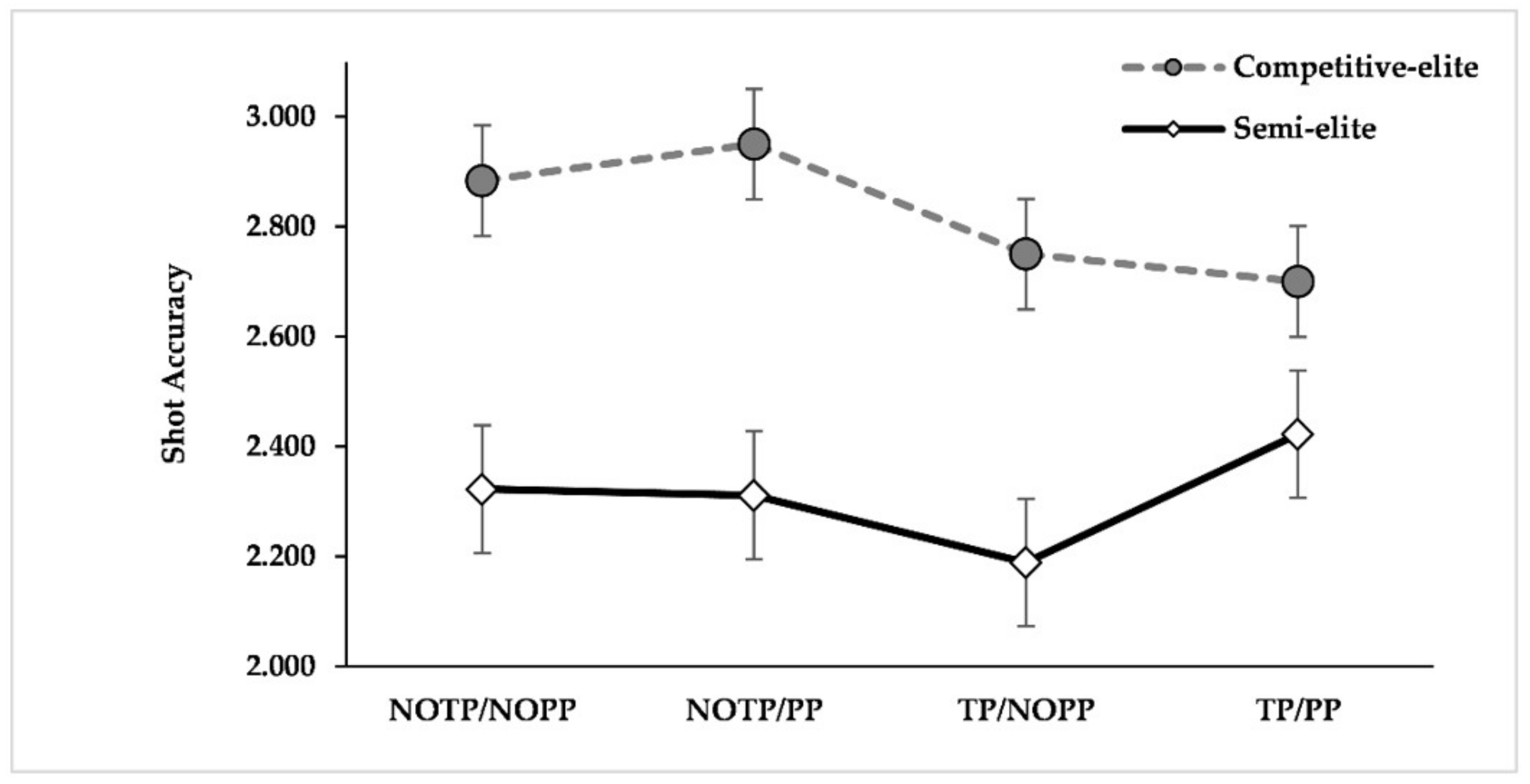
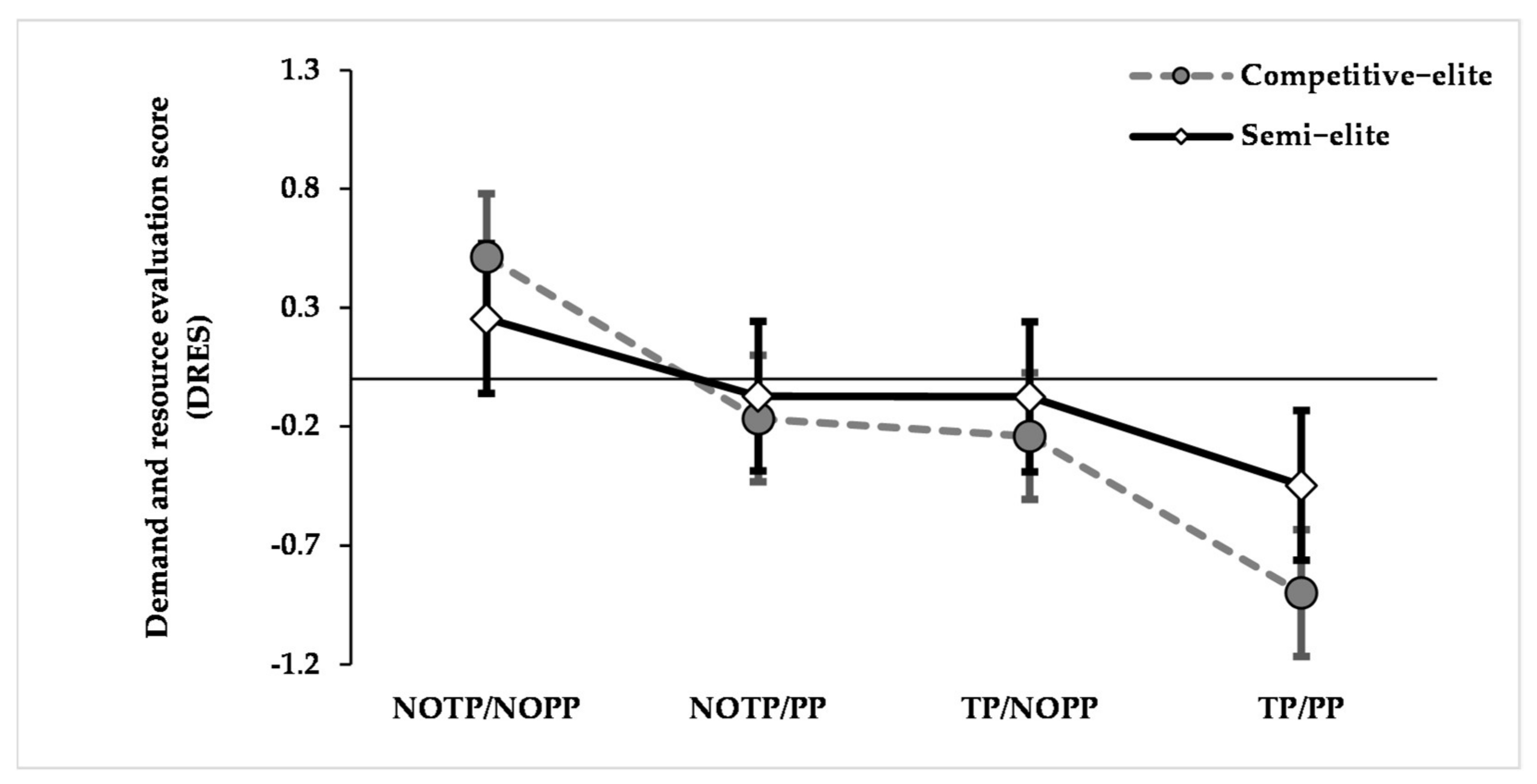
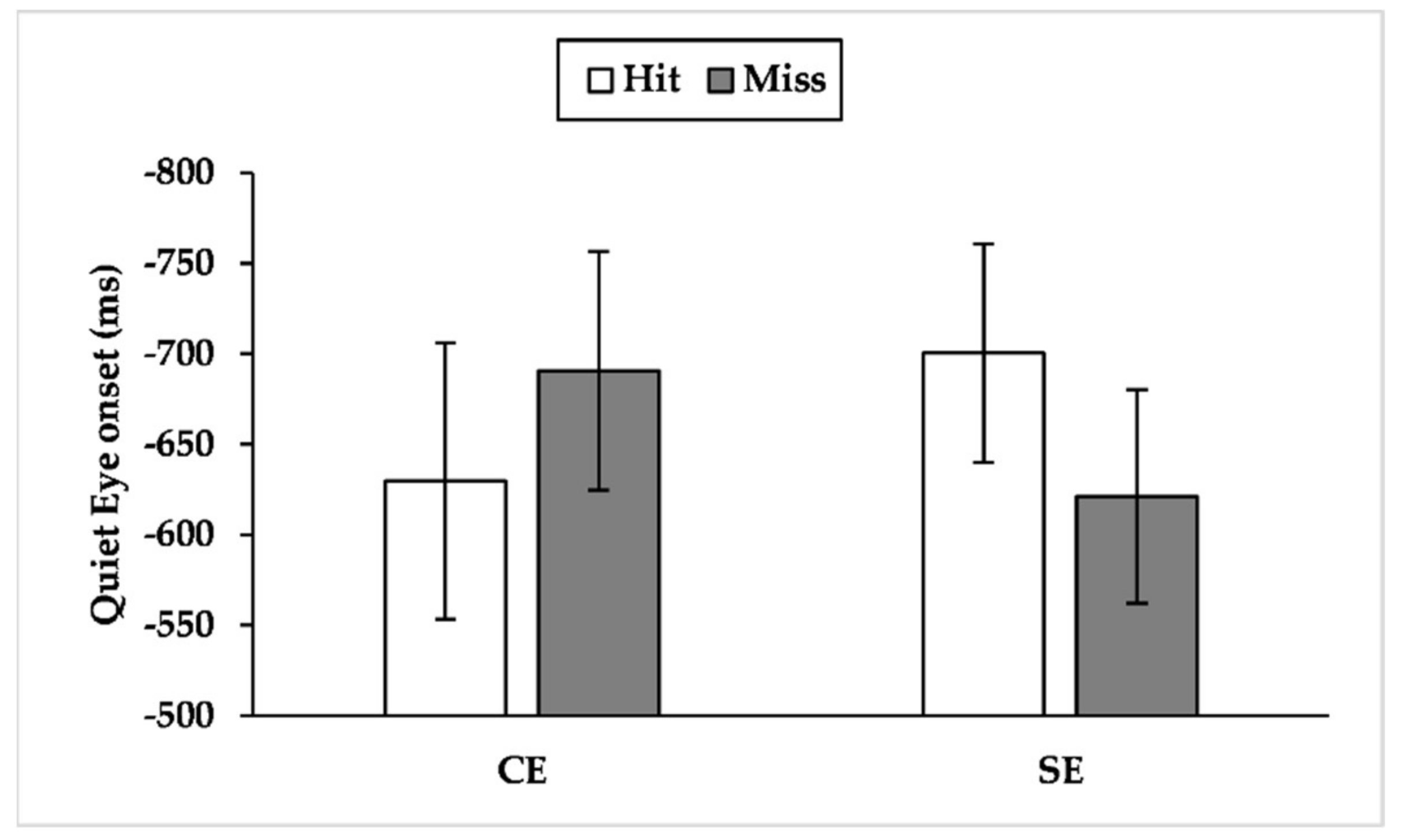

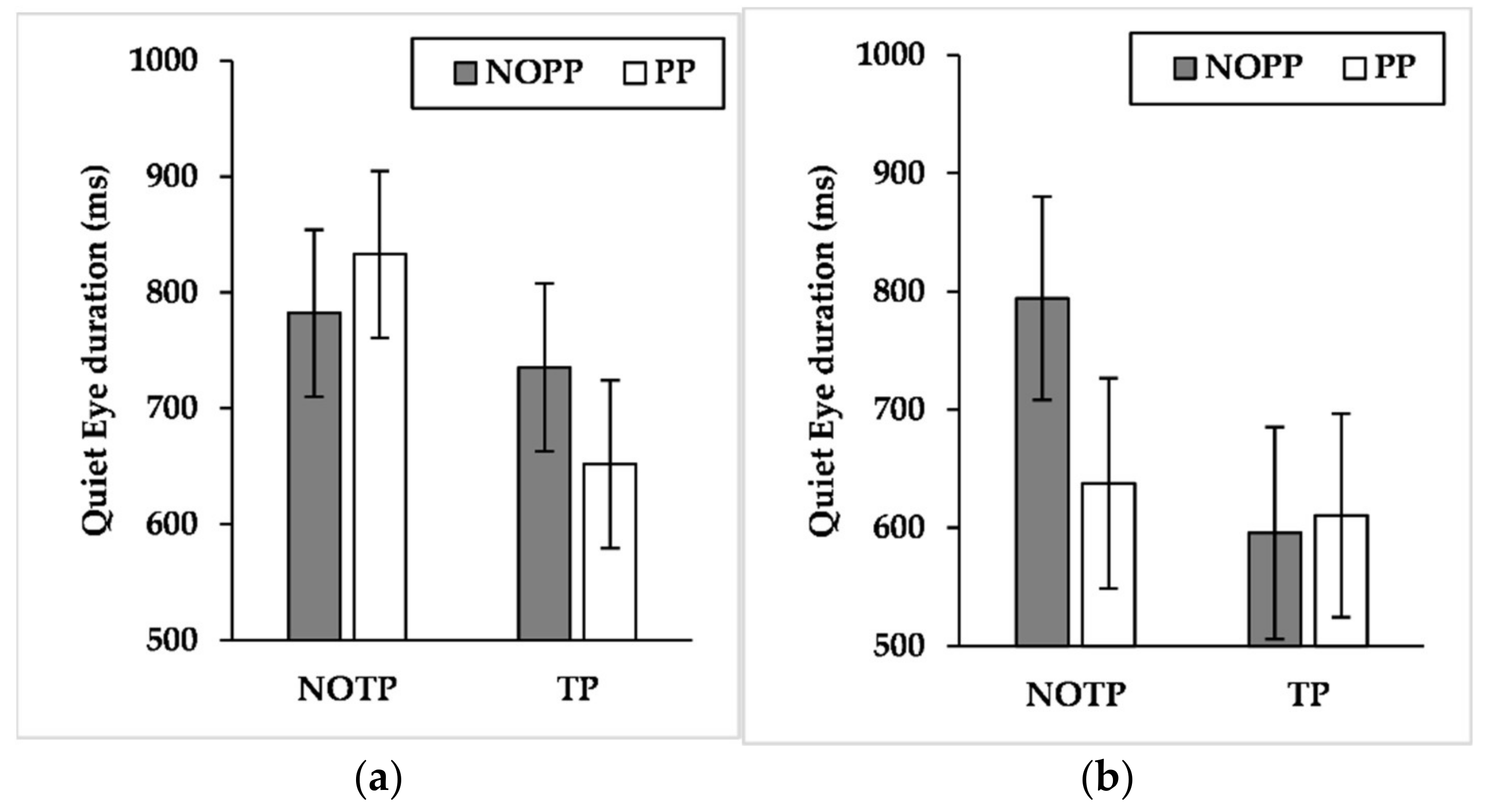
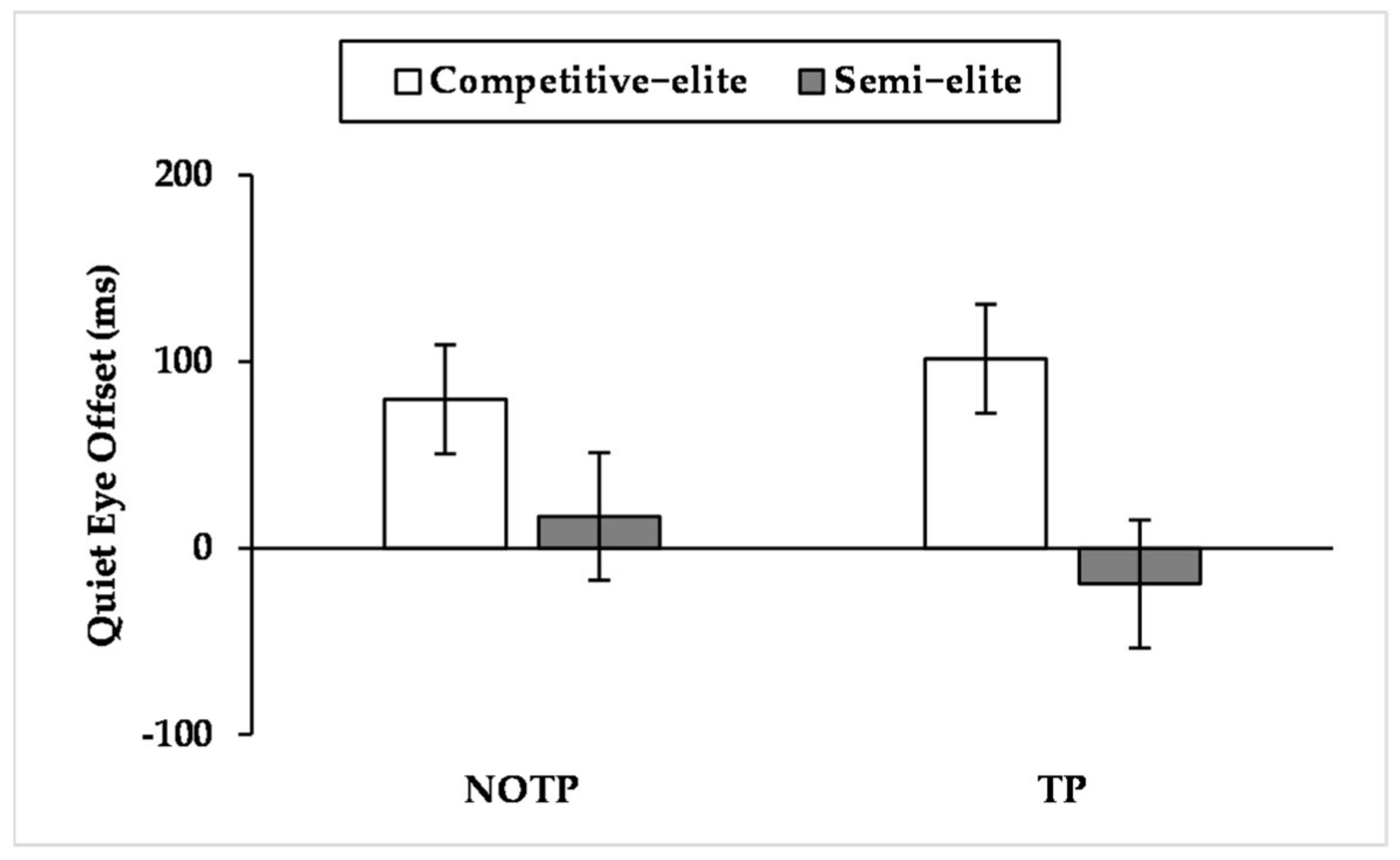
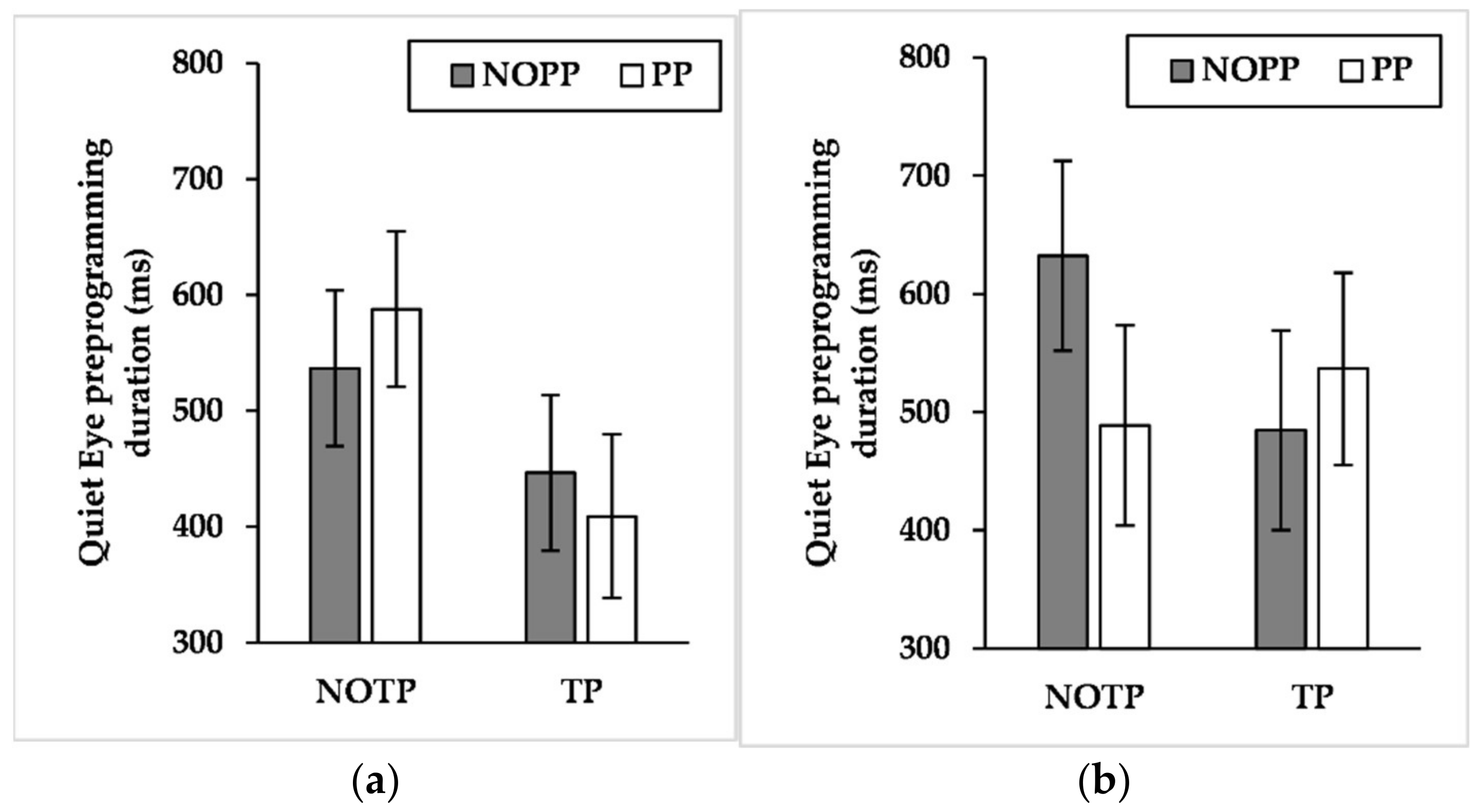
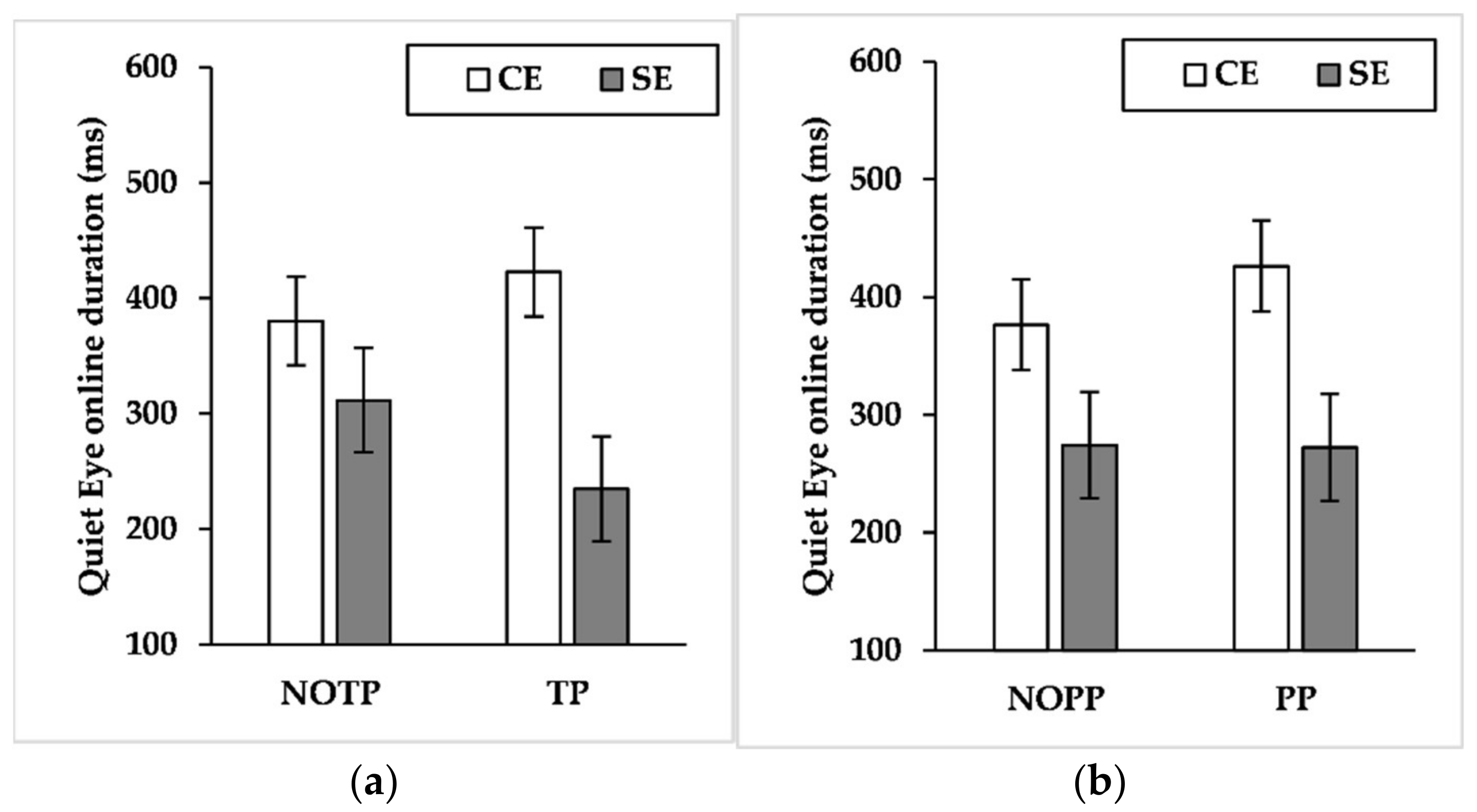


| Condition | Time Pressure | Performance Pressure | Condition’s Instructions |
|---|---|---|---|
| NOTP/NOPP | Absent | Absent | “Perform ten three-point shots.” |
| NOTP/PP | Absent | Present | “Perform ten three-point shots. It is very important to score as many points as you can because your score will be recorded to establish a ranking with your teammates.” |
| TP/NOPP | Present | Absent | “Perform ten three-point shots as fast as possible.” |
| TP/PP | Present | Present | “Perform ten three-point shots as fast as possible. It is very important to score as many points as you can because your score will be recorded to establish a ranking with your teammates.” |
| Sample | Condition | Throw Outcome | ||
|---|---|---|---|---|
| Hit | Miss | Total | ||
| Competitive-elite | NOTP/NOPP | 60 | 60 | 120 |
| NOTP/PP | 64 | 56 | 120 | |
| TP/NOPP | 49 | 71 | 120 | |
| TP/PP | 46 | 74 | 120 | |
| Total | 219 | 261 | 480 | |
| Semi-elite | NOTP/NOPP | 26 | 64 | 90 |
| NOTP/PP | 20 | 70 | 90 | |
| TP/NOPP | 19 | 71 | 90 | |
| TP/PP | 26 | 64 | 90 | |
| Total | 91 | 269 | 360 | |
| Total sample | NOTP/NOPP | 86 | 124 | 210 |
| NOTP/PP | 84 | 126 | 210 | |
| TP/NOPP | 68 | 142 | 210 | |
| TP/PP | 72 | 138 | 210 | |
| Total | 310 | 530 | 840 | |
| Expertise | Participant | Conditions | |||
|---|---|---|---|---|---|
| NOTP/NOPP | NOTP/PP | TP/NOPP | TP/PP | ||
| Competitive-elite | P1 | 60% | 50% | 70% | 50% |
| P2 | 40% | 70% | 20% | 30% | |
| P3 | 50% | 60% | 30% | 10% | |
| P4 | 40% | 30% | 40% | 40% | |
| P5 | 40% | 50% | 70% | 10% | |
| P6 | 50% | 50% | 20% | 40% | |
| P7 | 70% | 70% | 70% | 80% | |
| P8 | 50% | 60% | 50% | 70% | |
| P9 | 40% | 40% | 50% | 30% | |
| P10 | 50% | 30% | 30% | 30% | |
| P11 | 40% | 70% | 20% | 30% | |
| P12 | 70% | 60% | 20% | 40% | |
| Average | 50.00% | 53.33% | 40.83% | 38.33% | |
| SD | 11.28% | 14.35% | 20.65% | 20.82% | |
| Semi-elite | P13 | 10% | 10% | 20% | 10% |
| P14 | 20% | 0% | 20% | 10% | |
| P15 | 60% | 30% | 20% | 20% | |
| P16 | 20% | 10% | 10% | 50% | |
| P17 | 50% | 10% | 0% | 40% | |
| P18 | 20% | 30% | 30% | 60% | |
| P19 | 30% | 40% | 30% | 20% | |
| P20 | 20% | 20% | 20% | 30% | |
| P21 | 30% | 50% | 40% | 20% | |
| Average | 28.89% | 22.22% | 21.11% | 28.89% | |
| SD | 16.16% | 16.41% | 11.67% | 17.64% | |
| Total Sample | Average | 40.95% | 40.00% | 32.38% | 34.29% |
| SD | 17.00% | 21.68% | 19.72% | 19.64% | |
Publisher’s Note: MDPI stays neutral with regard to jurisdictional claims in published maps and institutional affiliations. |
© 2022 by the authors. Licensee MDPI, Basel, Switzerland. This article is an open access article distributed under the terms and conditions of the Creative Commons Attribution (CC BY) license (https://creativecommons.org/licenses/by/4.0/).
Share and Cite
Giancamilli, F.; Galli, F.; Chirico, A.; Fegatelli, D.; Mallia, L.; Palombi, T.; Lucidi, F. High-Pressure Game Conditions Affect Quiet Eye Depending on the Player’s Expertise: Evidence from the Basketball Three-Point Shot. Brain Sci. 2022, 12, 286. https://doi.org/10.3390/brainsci12020286
Giancamilli F, Galli F, Chirico A, Fegatelli D, Mallia L, Palombi T, Lucidi F. High-Pressure Game Conditions Affect Quiet Eye Depending on the Player’s Expertise: Evidence from the Basketball Three-Point Shot. Brain Sciences. 2022; 12(2):286. https://doi.org/10.3390/brainsci12020286
Chicago/Turabian StyleGiancamilli, Francesco, Federica Galli, Andrea Chirico, Dario Fegatelli, Luca Mallia, Tommaso Palombi, and Fabio Lucidi. 2022. "High-Pressure Game Conditions Affect Quiet Eye Depending on the Player’s Expertise: Evidence from the Basketball Three-Point Shot" Brain Sciences 12, no. 2: 286. https://doi.org/10.3390/brainsci12020286
APA StyleGiancamilli, F., Galli, F., Chirico, A., Fegatelli, D., Mallia, L., Palombi, T., & Lucidi, F. (2022). High-Pressure Game Conditions Affect Quiet Eye Depending on the Player’s Expertise: Evidence from the Basketball Three-Point Shot. Brain Sciences, 12(2), 286. https://doi.org/10.3390/brainsci12020286






